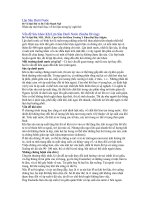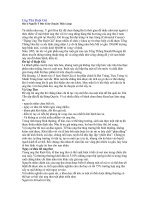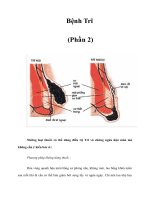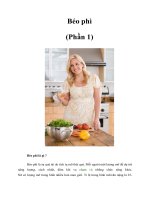Tài liệu DEJA REVIEW™ Internal Medicine ppt
Bạn đang xem bản rút gọn của tài liệu. Xem và tải ngay bản đầy đủ của tài liệu tại đây (3.23 MB, 477 trang )
DEJA REVIEW™
Internal Medicine
NOTICE
Medicine is an ever-changing science. As new research and clinical experience broaden
our knowledge, changes in treatment and drug therapy are required. The authors and the
publisher of this work have checked with sources believed to be reliable in their efforts to
provide information that is complete and generally in accord with the standards accepted at
the time of publication. However, in view of the possibility of human error or changes in
medical sciences, neither the authors nor the publisher nor any other party who has been
involved in the preparation or publication of this work warrants that the information
contained herein is in every respect accurate or complete, and they disclaim all
responsibility for any errors or omissions or for the results obtained from use of the
information contained in this work. Readers are encouraged to confirm the information
contained herein with other sources. For example and in particular, readers are advised to
check the product information sheet included in the package of each drug they plan to
administer to be certain that the information contained in this work is accurate and that
changes have not been made in the recommended dose or in the contraindications for
administration. This recommendation is of particular importance in connection with new or
infrequently used drugs.
DEJA REVIEW™
Internal Medicine
Sarvenaz S. Saadat, MD
School of Medicine
University of California, Irvine
Irvine, California
Resident in Family Medicine
Kaiser Permanente
Woodland Hills Medical Center
Woodland Hills, California
Copyright © 2008 by The McGraw-Hill Companies, Inc. All rights reserved.
Manufactured in the United States of America. Except as permitted under the United States
Copyright Act of 1976, no part of this publication may be reproduced or distributed in any
form or by any means, or stored in a database or retrieval system, without the prior written
permission of the publisher.
0071593764
The material in this eBook also appears in the print version of this title: 0-07-147716-0
All trademarks are trademarks of their respective owners. Rather than put a trademark
symbol after every occurrence of a trademarked name, we use names in an editorial fashion
only, and to the benefit of the trademark owner, with no intention of infringement of the
trademark. Where such designations appear in this book, they have been printed with initial
caps.
McGraw-Hill eBooks are available at special quantity discounts to use as premiums and
sales promotions, or for use in corporate training programs. For more information, please
contact George Hoare, Special Sales, at or (212)904-
4069.
TERMS OF USE
This is a copyrighted work and The McGraw-Hill Companies, Inc. (“McGraw-Hill”) and
its licensors reserve all rights in and to the work. Use of this work is subject to these terms.
Except as permitted under the Copyright Act of 1976 and the right to store and retrieve one
copy of the work, you may not decompile, disassemble, reverse engineer, reproduce,
modify, create derivative works based upon, transmit, distribute, disseminate, sell, publish
or sublicense the work or any part of it without McGraw-Hill’s prior consent. You may use
the work for your own noncommercial and personal use; any other use of the work is
strictly prohibited. Your right to use the work may be terminated if you fail to comply with
these terms.
THE WORK IS PROVIDED “AS IS.” McGRAW-HILL AND ITS LICENSORS MAKE
NO GUARANTEES OR WARRANTIES AS TO THE ACCURACY, ADEQUACY OR
COMPLETENESS OF OR RESULTS TO BE OBTAINED FROM USING THE WORK,
INCLUDING ANY INFORMATION THAT CAN BE ACCESSED THROUGH THE
WORK VIA HYPERLINK OR OTHERWISE, AND EXPRESSLY DISCLAIM ANY
WARRANTY, EXPRESS OR IMPLIED, INCLUDING BUT NOT LIMITED TO
IMPLIED WARRANTIES OF MERCHANTABILITY OR FITNESS FOR A
PARTICULAR PURPOSE. McGraw-Hill and its licensors do not warrant or guarantee that
the functions contained in the work will meet your requirements or that its operation will be
uninterrupted or error free. Neither McGraw-Hill nor its licensors shall be liable to you or
anyone else for any inaccuracy, error or omission, regardless of cause, in the work or for
any damages resulting therefrom. McGraw-Hill has no responsibility for the content of any
information accessed through the work. Under no circumstances shall McGraw-Hill and/or
its licensors be liable for any indirect, incidental, special, punitive, consequential or similar
damages that result from the use of or inability to use the work, even if any of them has
been advised of the possibility of such damages. This limitation of liability shall apply to
any claim or cause whatsoever whether such claim or cause arises in contract, tort or
otherwise.
DOI: 10.1036/0071477160
Want to learn more?
We hope you enjoy this McGraw-Hill eBook! If you’d like more information about this
book, its author, or related books and websites, pleaseclick here .
To my husband, for all his patience and encouragement. This
book would not have been possible without you.
To our baby, while still in the womb, whose kicks, squirms
and wiggles have brought smiles to my face daily. I hope that
I can inspire you as much as you inspire me.
To my parents, for always inspiring me to do bigger and
better things.
To my brother—keep reaching for the stars. You can achieve
anything you put your mind to.
Contents
Contributors
xi
Reviewers/Student Reviewer
xiii
Preface
xv
Introduction
xvii
Important Lab Values
xvii
Abbreviations You Should Know
xxiv
Chapter 1 - THE BASICS
1
Chest X-ray
1
Other Radiologic Studies
2
Fluids
6
Electrolytes
7
Chapter 2 - CARDIOLOGY
21
Hypertension
21
Hyperlipidemia
22
Coronary Artery Disease
23
Arrhythmias
26
Congestive Heart Failure
29
Valvular Heart Diseases
30
Cardiomyopathy
31
Endocarditis
32
Rheumatic Fever
35
Pericarditis
36
Myocarditis
38
Cardiac Tamponade
38
Chapter 3 - PULMONOLOGY
41
Hypoxia
41
Obstructive Pulmonary Diseases
43
Restrictive Lung Disease
46
Pleural Effusion
47
Cough 48
Acute Respiratory Distress Syndrome
49
Pulmonary Embolism
50
Pneumothorax
53
Hemoptysis
53
Lung Cancer
54
Pneumonia
56
Tuberculosis
59
Chapter 4 - NEUROLOGY
61
Cerebrovascular Accidents
61
Seizure Disorders
63
Meningitis
65
Brain Tumors
67
Demyelinating Diseases
68
Cognitive Disorders
70
Headache
74
Intracranial Bleeding
75
Vertigo
76
Chapter 5 -
GASTROENTEROLOGY
77
Esophageal Disorders
77
Gastroesophageal Reflux Disease
78
Gastritis
79
Peptic Ulcers
80
GI Bleed
82
Colon
83
Inflammatory Bowel
87
Diarrhea
89
Malabsorption Disorders
89
Pancreas
90
Biliary Tract
92
Liver
94
Chapter 6 - HEMATOLOGY–
ONCOLOGY
99
Anemia
99
Microcytic Anemias
100
Macrocytic Anemias
102
Normocytic Anemia
103
Coagulopathies
105
Leukemias
108
Lymphoma
111
Myeloproliferative Diseases
113
Chapter 7 - RHEUMATOLOGY
117
Arthropathies
117
Systemic Disorders
120
Muscle Disorders
125
Vasculitis
126
Chapter 8 - NEPHROLOGY
129
Acute Renal Failure
129
Chronic Renal Failure
132
Glomerulonephropathies
133
Urinary Tract
135
Acid-Base Disorders
137
Renal Artery Stenosis
139
Chapter 9 - ENDOCRINOLOGY
141
Diabetes
141
Pituitary
144
Thyroid
146
Parathyroid
151
Adrenals
153
Bones
157
Chapter 10 - INFECTIOUS
DISEASE
161
HIV/AIDS
161
Sexually Transmitted Diseases
163
Sepsis
166
Osteomyelitis
166
Chapter 11 - DERMATOLOGY
169
Terminology
169
Skin Cancers
170
Psoriasis
173
Blistering Diseases
174
Vector-Borne Diseases
175
Fungal Infections
177
Bacterial and Viral Infections
178
Pigmentary Disorders
182
Hypersensitivity Reactions
182
Chapter 12 - CLINICAL
VIGNETTES
189
Index
197
Contributors
Copyright © 2008 by The McGraw-Hill Companies, Inc. Click here for terms of use
.
Noah Craft, MD PhD, DTM&H
Assistant Professor
Department of Internal Medicine,
Division of Dermatology
Harbor-UCLA Medical Center
Los Angeles, California
Henry J. Feldman, MD
Medical Informatics,
Division of General Internal Medicine,
Department of Internal Medicine
NYU School of Medicine
New York
William Herring, MD, FACR
Vice Chairman and Radiology Residency
Program Director
Albert Einstein Medical Center
Philadelphia, Pennsylvania
Reviewers
Copyright © 2008 by The McGraw-Hill Companies, Inc. Click here for terms of use
.
Daniel Behroozan, MD
Department of Dermatology
University of California
Los Angeles, California
Paul Bellamy, MD
Department of Pulmonary and Critical
Medicine
Kaiser Permanente
Woodland Hills Medical Center
Woodland Hills, California
Jia-ling Chou, MD
Department of Hematology-Oncology
Kaiser Permanente
Woodland Hills Medical Center
Woodland Hills, California
Afshin Khatibi, MD
Department of Gastroenterology
Kaiser Permanente
Woodland Hills Medical Center
Woodland Hills, California
Rashmi Nadig
Department of Infectious Disease
Kaiser Permanente
Woodland Hills Medical Center
Woodland Hills, California
Pamela Nagami, MD
Department of Infectious Disease
Kaiser Permanente
Woodland Hills Medical Center
Woodland Hills, California
Braden Nago, MD
Department of Neurology
Kaiser Permanente
Woodland Hills Medical Center
Woodland Hills, California
Frederick Ziel, MD
Department of Endocrinology
Kaiser Permanente
Woodland Hills Medical Center
Woodland Hills, California
Student Reviewer
Copyright © 2008 by The McGraw-Hill Companies, Inc. Click here for terms of use
.
Mary M. Bonar
College of Osteopathic Medicine
Ohio University
Dayton, Ohio
Preface
Copyright © 2008 by The McGraw-Hill Companies, Inc. Click here for terms of use.
The principles learned ininternal medicine are the fundamental core principles applied in
clinical medicine as well as the largest proportion of questions posed on the USMLE Step 2
exam. In order to do well both on the wards and on the Step 2 exam, you must have a solid
foundation in these principles. This guide has been written as a high-yield resource, to
endorse the rapid recall of the essential facts in a well-organized and efficient manner.
Organization
All concepts are presented in a question and answer format that covers the key facts on
hundreds of commonly tested internal medicine topics that may appear on the USMLE Step
2 exam. The material is divided into chapters organized by internal medicine subcategories,
along with a special chapter at the end that incorporated the material with their clinical
presentation and relevance.
This question and answer format has several advantages:
• It provides a rapid, straightforward way for you to assess your strengths and weaknesses.
• It allows you to efficiently review and commit to memory a large body of information.
• It offers a break from tedious, convoluted multiple choice questions.
• The clinical vignettes incorporated expose you to the prototypical presentation of
diseases classically tested on USMLE Step 2.
• It serves as a quick, last minute review of high-yield facts.
The compact, condensed design of the book is conducive to studying on the go, especially
during any downtime throughout your day.
How to use this book
This text is intended to be used not only to study for the USMLE Step 2 examination but is
also an essential tool while on the internal medicine and medicine subspecialty rotations,
and during medical school. Remember, this text is not intended to replace comprehensive
textbooks, course packets, or lectures. It is simply intended to serve as a supplement to your
studies during your internal medicine clinical rotation and throughout your preparation for
Step 2. We encourage you to begin using this book early in your third year to reinforce
topics you encounter while on the wards. Also, it is recommended that you cover up the
answers (rather than just reading both the questions and the answers) and quiz yourself or
even your classmates. Carry the book in your white coat pocket so that you can easily
access study material during down time. However you choose to study, we hope you find
this resource helpful throughout your clinical years and during your preparation for
USMLE Step 2. Best of Luck!
Sarvenaz S. Saadat, MD
Introduction
Copyright © 2008 by The McGraw-Hill Companies, Inc. Click here for terms of use
.
Important Lab Values
Blood Test
Value
Albumin, serum
3.2–5.5 g/dL
Alkaline phosphatase
26–110 IU/L
Ammonia, plasma 17–60 µmol/L
Amylase, serum
25–125 IU/L
Bilirubin
Direct
0–0.2 mg/dL
Total
0–1.4 mg/dL
Calcium
9–10.6 mg/dL
Chloride
101–111 mEq/L
CO2
25–34 mEq/L
Cortisol, a.m.
6–28 µg/dL
Cortisol, p.m.
3–16 µg/dL
CPK
22–269 U/L
Creatinine
0.5–1.3 mg/dL
ESR, male
0–15 mm/h
ESR, female
0–20 mm/h
d–Dimer
< 0.5 µg/mL
Ferritin, male
23–233 ng/mL
Ferritin, female
10–1107 ng/mL
Folate
3–18.2 ng/mL
Glucose
70–115
Hemoglobin, male
13.5–16.9 g/dL
Hemoglobin, female
11.5–15 g/dL
Hematocrit, male
39.5–50%
Hematocrit, female
34–44%
Iron, male
49–181 µg/dL
Iron, female
37–170 µg/dL
LDH
91–180 IU/L
Lipase
4–24 IU/L
Magnesium
1.8–2.5 mg/dL
Osmolality, serum
278–305 mosmol/kg
Osmolality, urine
50–1200 mosmol/kg
Phosphorus
2.5–4.6 mg/dL
Platelets 150–450,000
Potassium
3.3–4.8 mEq/L
Pre-albumin
18–45 mg/dL
PSA, Age 0–39
0–1.4 ng/mL
PSA, Age 40+
0–2.8 ng/mL
Protein, total
6.7–8.2 g/dL
Reticulocyte count
0.5–1.5%
SGOT
10–42 U/L
SGPT
< 60 U/L
Sodium
135–145 mEq/L
T3 uptake
25–38%
T4 total
0.7–2.1 ng/dL
Transferrin
212–360 mg/dL
TSH
0.5–5.0 µIU/mL
Uric acid
2.6–7.2 mg/dL
WBC
4500–10,500
Writing Notes
Daily progress note:This should be in SOAP format.
Subjective:In this area you should report any overnight events, how the patient is feeling
today, any complaints or problems the patient may be experiencing, and pertinent positives
and negatives.
Objective:Any physical findings are reported in this section.
Vitals: temperature, max temperature, blood pressure, pulse, respiratory rate, oxygen
saturation
Glucose (if patient is diabetic): Ins and Outs (Ins = IV fluids + po intake + any parenteral
intake or blood products over 24 hours and Outs = urine output + stool + other [NG tube,
chest tube, drains, emesis])
Physical examination:
General: Patients general appearance
HEENT (head, eyes, ears, nose, throat)
Cardiovascular
Pulmonary
Abdomen
Extremities
Neurologic
Labs: Laboratory tests are reported here.
Complete blood count (CBC).
Chemistry 7.
Meds: Some people include a list of all the medication the patient is currently
using.Assessment andplan: Write a summary of the patient, their problem(s) and possible
differentials. Then write the plan for each problem.
X
Sign your note
Example
S: Patient has no complaints today. She is no longer short of breath and was able to
ambulate yesterday.
O: T: 36.8, Tmax 37°C, P: 70–85, BP: 128–148/68–80, RR: 20, O2sat: 95–100%, I/O:
1500/2000
GEN: NAD (no apparent distress)
HEENT: PERRLA (pupils are equally round and reactive to light accommodation), EOMI
(extraocular muscles are intact), NCAT (normocephalic atraumatic)
CV: RRR no M/R/G (regular rate and rhythm with no murmurs, rubs, or gallops) Pulm:
CTA B (clear to auscultation bilaterally); no R/R/W (no rhonchi, rales, or wheezes)
Abd: S (soft)/NT (non-tender)/ND (non-distended)/NABS (normal abdominal bowel
sounds)
Ext: no C (clubbing)/C (cyanosis)/E (edema); no calf tenderness
Labs: CBC.
Meds: Aspirin 81 mg daily
Albuterol nebs q4 hours
A/P: 35 y/o female with asthma exacerbation now improved and at baseline
1. Asthma: Patient improved with steroids and albuterol/atrovent treatments. Patient will
be sent home with a medrol pack and albuterol inhaler. Patient will also be sent home with
a steroid inhaler.
2. Disposition: Patient will be discharged home today with follow-up in 1 week.
Greta Student, MS III
History and Physical Examination
Chief complaint (CC):Main problem that the patient is here for (e.g., shortness of breath)
History of present illness (HPI):Include a chronologic history of the patient’s problems
and prior treatments for this problem as well as any other history that is pertinent. Describe
symptoms in terms of onset, duration, quality of discomfort, setting, instigating and
relieving factors.
Past medical history (PMH):Include the patient’s medical history and be sure to ask
about heart disease, hypertension, diabetes, cancer, and any other pertinent history. The
patient’s medication list can often serve as a clue since patients will sometimes forget to
mention medical problems that they have.
Surgical history (SH):Include all operations a patient has as well as when and why.
Medication:List all the patient’s medications as well as doses and frequency with which
they are taken. Also ask the patient about any possible over-the-counter medications and
alternative meds.
Allergies:Name all drugs the patient is allergic to and what happened when they took the
drug.
NKDA means “no known drug allergies”
Family history (FH):This should include the health, medical problems of the patient’s
family including parents, grandparents, siblings, and often, aunts, uncles, and cousins. Be
sure to ask about heart disease, diabetes, hypertension, hyperlipidemia, and cancer.
Social history (SH):This section includes the patient’s marital status, occupation, exercise
history, sexual history, diet, and tobacco use, drug use, and alcohol use.
Review of systems (ROS):Report all the pertinent positive and negative signs and
symptoms that the patient reports (e.g., the patient denies any nausea, vomiting, diarrhea,
chest pain, cough, travel history, …)
Physical examination:Include all pertinent organs and systems
Vital signs: Tmax, BP, HR, RR, O2saturation, Ins/Outs
General:
HEENT:
Neck:
Cardiovascular:
Pulmonary:
Abdominal:
Genitourinary:
Back:
Extremities:
Neurologic:
Labs and studies:Include all labs and studies that you have results for Assesment and
plan: Write a summary of the patient’s problems and differential diagnoses as well as a plan









